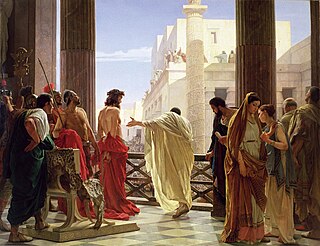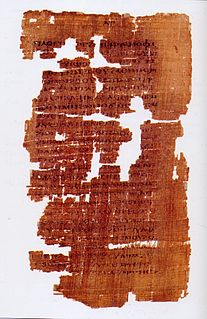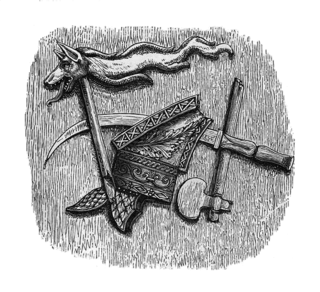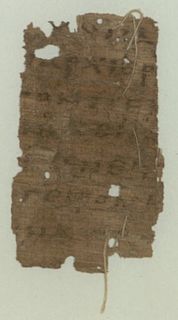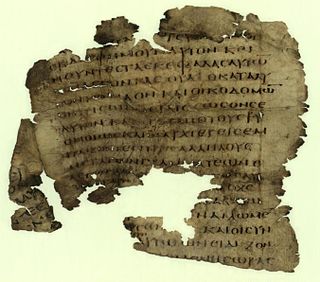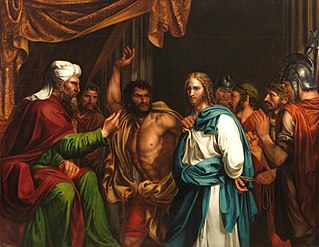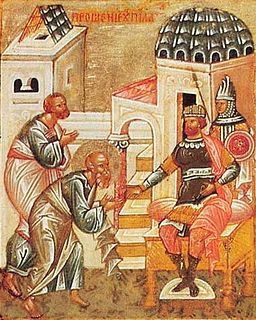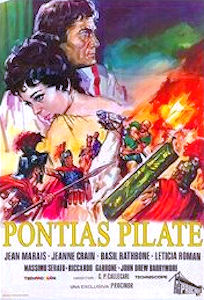A simpulum, or simpuvium, was a small vessel or ladle with a long handle from the Roman era, used at sacrifices to make libations, and to taste the wines and other liquors which were poured on the head of the sacrificial victims. The simpulum was the sign of Roman priesthood, and one of the insignia of the College of Pontiffs. [1]

A ladle (dipper) is a type of spoon used for soup, stew, or other foods. Although designs vary, a typical ladle has a long handle terminating in a deep bowl, frequently with the bowl oriented at an angle to the handle to facilitate lifting liquid out of a pot or other vessel and conveying it to a bowl. Some ladles involve a point on the side of the basin to allow for finer stream when pouring the liquid; however, this can create difficulty for left handed users, as it is easier to pour towards one's self. Thus, many of these ladles feature such pinches on both sides.

Religion in Ancient Rome includes the ancestral ethnic religion of the city of Rome that the Romans used to define themselves as a people, as well as the religious practices of peoples brought under Roman rule, in so far as they became widely followed in Rome and Italy. The Romans thought of themselves as highly religious, and attributed their success as a world power to their collective piety (pietas) in maintaining good relations with the gods. The Romans are known for the great number of deities they honored, a capacity that earned the mockery of early Christian polemicists.

The College of Pontiffs was a body of the ancient Roman state whose members were the highest-ranking priests of the state religion. The college consisted of the Pontifex Maximus and the other pontifices, the Rex Sacrorum, the fifteen flamens, and the Vestals. The College of Pontiffs was one of the four major priestly colleges; originally their responsibility was limited to supervising both public and private sacrifices, but as time passed their responsibilities increased. The other colleges were the augurs, the quindecimviri sacris faciundis , and the Epulones.
The simpulum appears on a coin from Patras struck under Augustus. It is placed before the head of Vesta, as a mark of that goddess, on a coin of the Domitian family, and is seen in the hand of a Vestal Virgin on coins of the Julio-Claudian dynasty. A man in a toga holds a simpulum in his hand on a coin of Antonio Drusi.

Patras is Greece's third-largest city and the regional capital of Western Greece, in the northern Peloponnese, 215 km (134 mi) west of Athens. The city is built at the foothills of Mount Panachaikon, overlooking the Gulf of Patras.

Augustus was a Roman statesman and military leader who was the first Emperor of the Roman Empire, controlling Imperial Rome from 27 BC until his death in AD 14. His status as the founder of the Roman Principate has consolidated an enduring legacy as one of the most effective and controversial leaders in human history. The reign of Augustus initiated an era of relative peace known as the Pax Romana. The Roman world was largely free from large-scale conflict for more than two centuries, despite continuous wars of imperial expansion on the Empire's frontiers and the year-long civil war known as the "Year of the Four Emperors" over the imperial succession.

Vesta is the virgin goddess of the hearth, home, and family in Roman religion. She was rarely depicted in human form, and was often represented by the fire of her temple in the Forum Romanum. Entry to her temple was permitted only to her priestesses, the Vestals, who tended the sacred fire at the hearth in her temple. As she was considered a guardian of the Roman people, her festival, the Vestalia, was regarded as one of the most important Roman holidays. During the Vestalia matrons, the city walked barefoot to the sanctuary of the goddess, and gave offerings. Such was Vesta's importance to Roman religion that hers was one of the last republican pagan cults still active following the rise of Christianity until it was forcibly disbanded by the Christian emperor Theodosius I in AD 391.

The simpulum is commonly shown with the lituus and other sacrificial and augural instruments, on coins of Julius Caesar, Mark Antony, Marcus Aemilius Lepidus, Augustus, Caligula, Vespasian, Nerva, Antoninus Pius, Marcus Aurelius, Caracalla, Publius Septimius Geta, Volusianus, Saloninus, Valerianus Minor, Domitius Calvinus and Pontius Pilate, as well as on many consular and colonial medals. [1]

The word lituus originally meant a curved augural staff, or a curved war-trumpet in the ancient Latin language. This Latin word continued in use through the 18th century as an alternative to the vernacular names of various musical instruments.

Gaius Julius Caesar, known by his nomen and cognomen Julius Caesar, was a Roman politician, military general, and historian who played a critical role in the events that led to the demise of the Roman Republic and the rise of the Roman Empire. He is also known as an author of Latin prose.

Marcus Antonius, commonly known in English as Mark Antony or Anthony, was a Roman politician and general who played a critical role in the transformation of the Roman Republic from an oligarchy into the autocratic Roman Empire.
